We booked the O.A.T. (Overseas Adventure Travel) tour called The Best Of Kenya & Tanzania from June 15-July 2nd. We also booked this pre-trip extension - Kenya: Samburu and Sweetwaters Game Reserves, to visit parks that have animals we won't get to see on the main trip such as the Grevy's Zebra, Reticulated Giraffe and White Rhino.
We left from DFW at 9:30am on Wednesday June 7, 2023 and flew to Atlanta and then on to Amsterdam where we spent our 6 1/2 hour layover in the KLM lounge. A little over 30 hours after leaving Dallas, we landed in Nairobi on time at around 10pm Thursday evening.
An interesting cloud formation as we fly past Italy.
After getting our luggage, we were met by an OAT driver, Daniel. Initially waiting for another arriving passenger whose flight was quite late, Daniel went and put us in a van to our hotel. By the time we arrived, got checked in and made it to our room and showered, it was past 2AM (Friday). Luckily we decided to arrive a day early to have time to recover before the actual start of the trip.
On Friday, Emerson, Linda and Debbie Clain from Boston, another early arrival for our OAT pre-trip are taken to the Nairobi National Museum by Daniel our OAT driver.
As we approach, we see a bunch of schools kids as they are leaving the museum.
Here Daniel explains the artwork in front of the museum. He picks us up again after we tour the inside of the museum.
Our guide in the museum, Rispa, shows us around. BTW - Kenya has two official lanquages, Swahili and English, so no problems with communication! Here she talks about the Masai headdress.
Some information about the headdress.
Some African wildlife. The skull with the really long tusks belonged to Ahmed a famous male elephant granted special government protection in 1970 due to his beautifully proportioned tusks weighing over 150 lbs each. He died in 1974 at age 55.
About Ahmed.
Sudan was the last living male Northern White Rhino. He died in 2018 at the age of 46.
Kenya gains independance from Great Britan. The first president of Kenya was Jomo Kenyatta. He had been imprisoned by the British for being an independance leader and starting the Mao Mao rebellion.
In Tanzania the government also owns all of the land.
Daniel is there to pick us up as we leave and snaps our photo.
Our room in the EKA hotel in Nairobi.
Our OAT trip leader escorts us and joins us for dinner at a restaurant down the street from our hotel located on the top floor a building called The Curve. Here you can see toward downtown Nairobi a city with over 5 million inhabitants.
We had a delicious meal at the The Curve along with Allen Martin, our (wonderful!) trip leader, here showing us a popular beer in Kenya...
...and our other fellow travelers Linda Anneberg, her husband Mike Farley from Kansas City, KS...
...and Debbie.
Another view from The Curve. To the left is Nairobi National Park a 117 sq km wildlife park that comes right up to the city.
Back at our hotel there's rooftop music and free beer and wine. The dancers in front with white shoes and similar outfits are there to lead the dancing. Our group joined in the fun!
Next day's schedule.
Saturday June 10
The next morning we board a plane at nearby Wilson regional airport in Nairobi and head to the Samburo Game Reserve. Small planes are the reason we're limited to 33 lbs total for checked and carry on luggage. The luggage was not checked individually, just the total for the group and we had no problems.
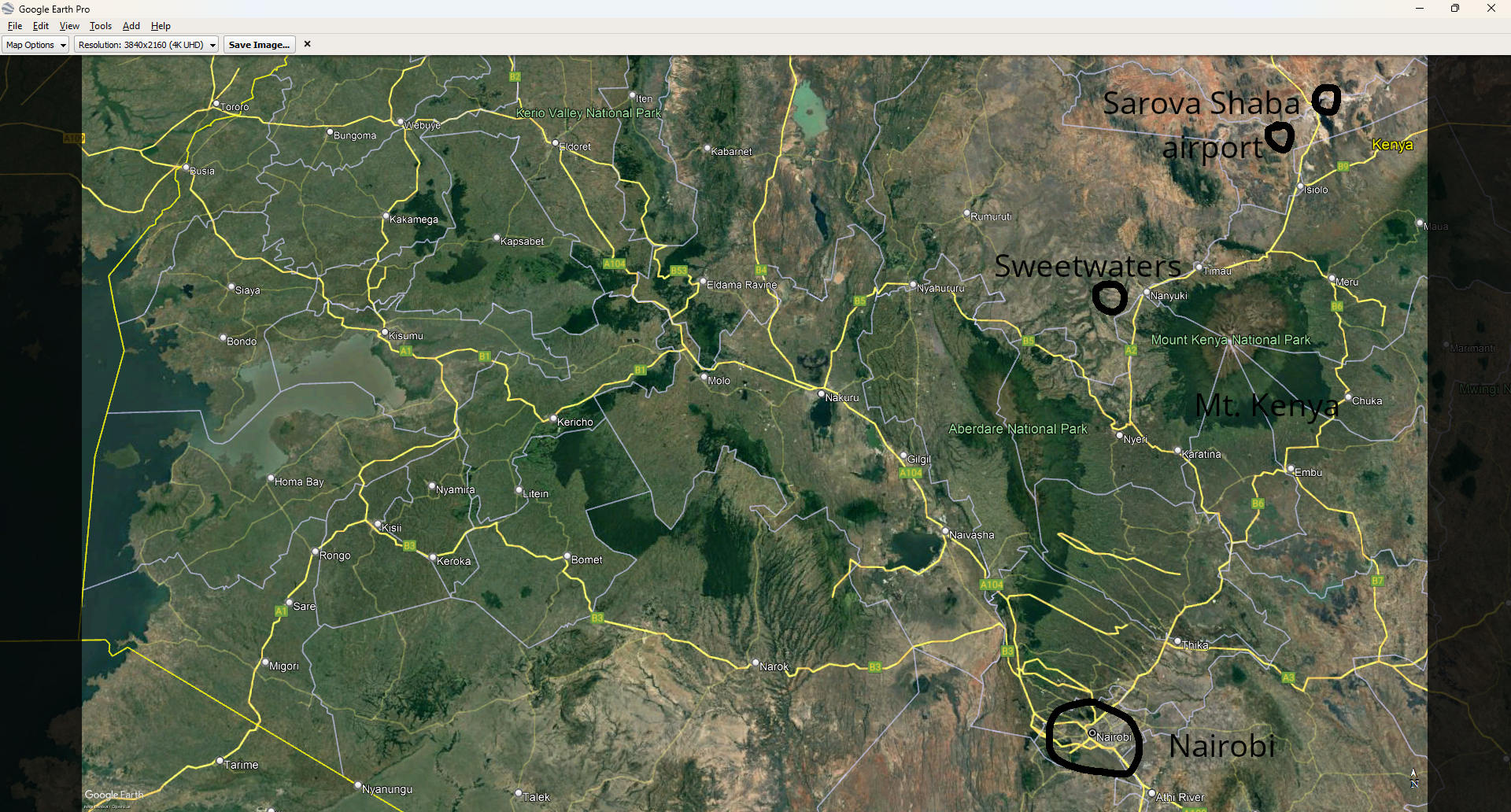 Flying north out of Nairobi and to the west of Mount Kenya (highest peak 17,058 ft (5199 metres)), we land at Samburu airport and drive to Sarova Shaba camp. We spend two nights there and then drive to Sweetwaters and visit Ol Pejeta Conservancy. After two more nights we drive back to Nairobi.
Flying north out of Nairobi and to the west of Mount Kenya (highest peak 17,058 ft (5199 metres)), we land at Samburu airport and drive to Sarova Shaba camp. We spend two nights there and then drive to Sweetwaters and visit Ol Pejeta Conservancy. After two more nights we drive back to Nairobi.
Right after takeoff from Nairobi's local Wilson Airport, we fly over Nairobi National Park heading North. The park is fenced on three sides, while the remaining side is open to allow for animal migrations.
We fly past Mt Kenya. The runoff from the slopes and remaining glaciers provide a lot of the water for the surrounding area.
Lots of greenhouses. Roses are a big export from the area.
We arrive at Samburo airfield.
Luxurious facilities at this bush airport!
We get ready to load into our first safari vehicle, a converted Toyota Land Cruiser which is the vehicle of choice at all the different OAT camps throughout our trip. A Tanzanian company takes the Land Cruiser cab and chassis and adds the new shell.
Desert Rose bush.
Termite mound .
 Our first Gerenuk, also known as a giraffe gazelle, it is a long-necked medium-sized antelope.
Mike Farley photo
Our first Gerenuk, also known as a giraffe gazelle, it is a long-necked medium-sized antelope.
Mike Farley photo
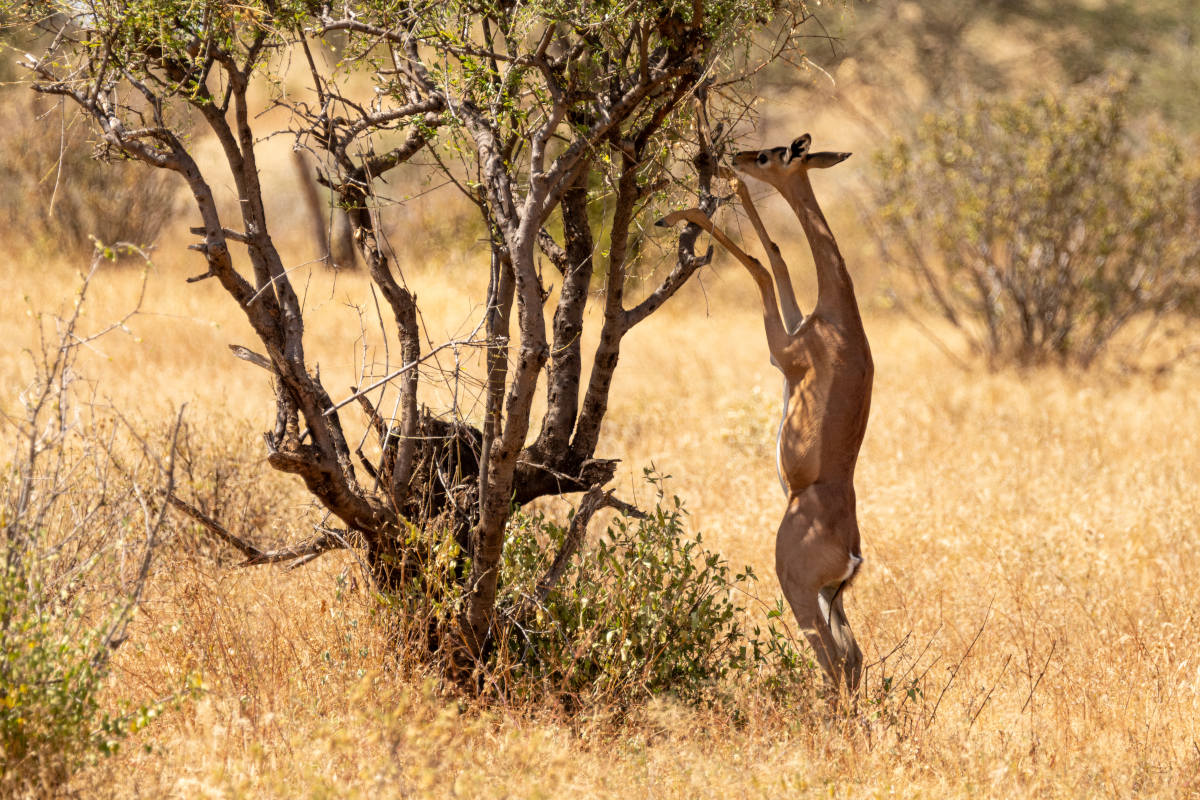 Gerenuk seen here browsing.
Mike Farley photo
Gerenuk seen here browsing.
Mike Farley photo
An acacia tree with weaver bird nests.
A weaver bird nest.
A grey headed silverbill weaver bird going into its nest that is constructed to enter from the bottom. There are many different types of weaver bird.
We soon learn that Allen is a birder as he starts showing us birds along the route to our hotel, the Sarova Shaba Game Lodge. Below are some of the birds we saw on our first day.
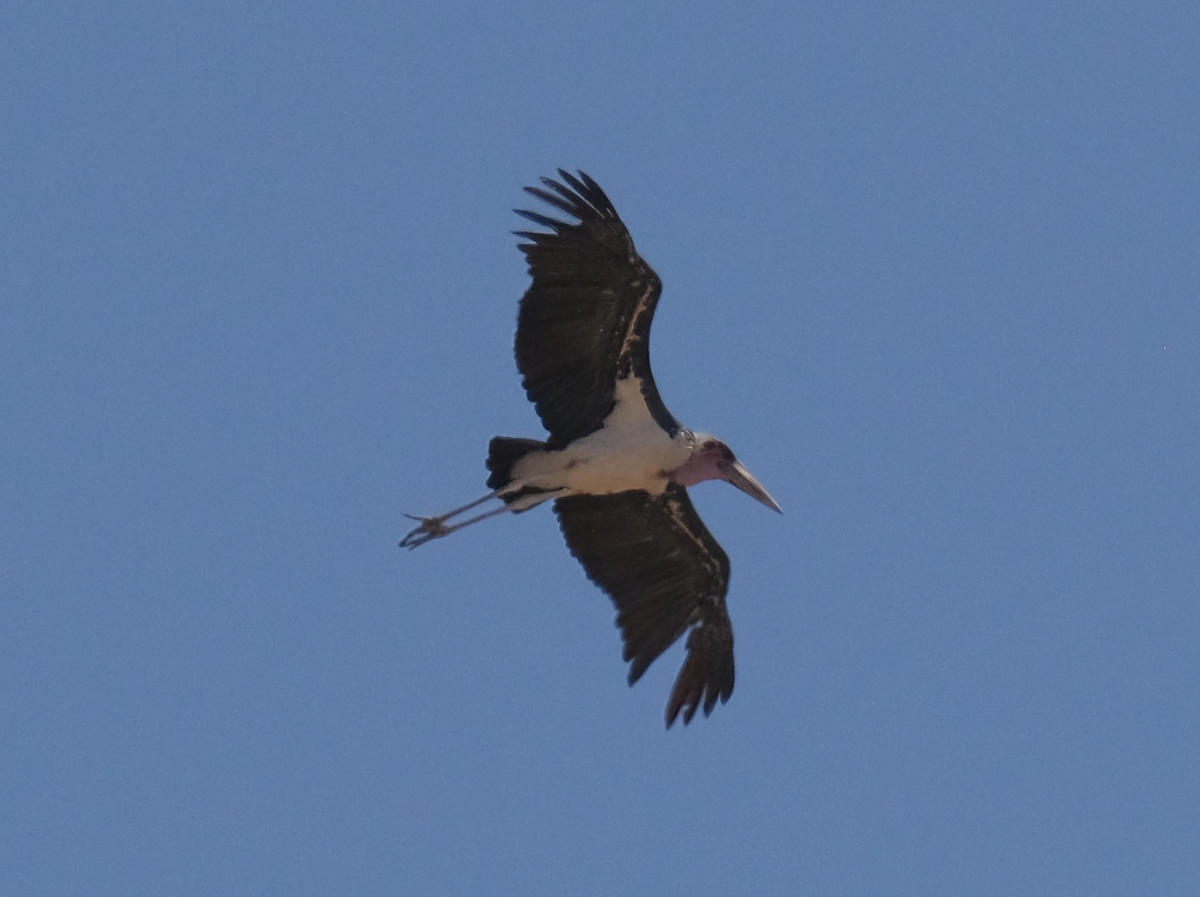 Marabou Stork.
Marabou Stork.
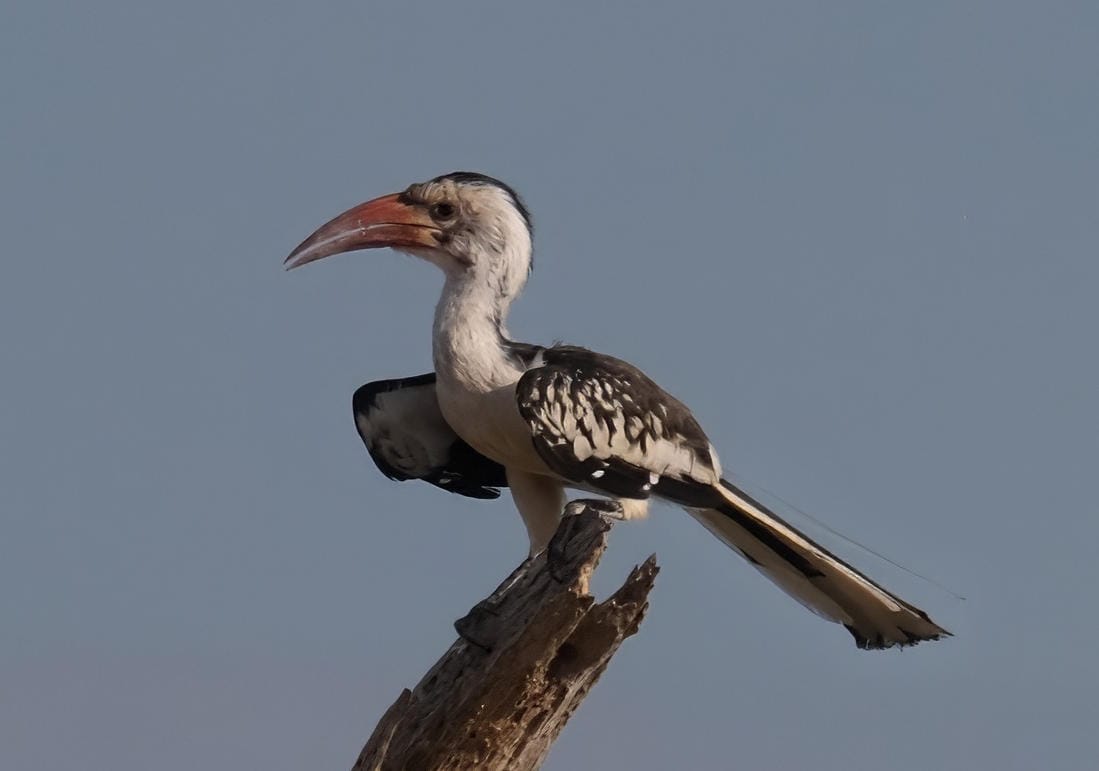 Northern Red-Billed Hornbill.
Northern Red-Billed Hornbill.
Grey-headed Kingfisher.
A Swahili sparrow.
White-bellied go-away-bird.
Little Bee-Eater .
Chestnut-bellied Sandgrouse.
A spur-winged lapwing.
Our first dik-dik.
A tamarind tree. It's edible fruit is used extensively in food, beverages and traditional medicines.
Impalas are medium size antelope with a distinctive M on their rump.
We see our first Grevy's Zebra on this trip! They have the tightest stripes of all zebras and a white underbelly.
Beisa Oryx - antelope seen in this region of Kenya whose status is "near threatened". We are fortunate to see some on this trip.
A female Somali ostrich.
On the road between our lodge and the park, we see the first of many livestock herders that we will see during our time in East Africa.
Common Waterbuck, a stocky antelope with a distinctive white ring on the rump.
Our first elephant.
We arrive at Sarova Shaba Game Lodge where we enjoy lunch and get checked into our rooms. We'll stay here 2 nights.
 Google view of Sarova Shaba Game Lodge grounds with arrow pointing to our room.
Google view of Sarova Shaba Game Lodge grounds with arrow pointing to our room.
Our room is located on the second floor.
Our lovely room at Sarova Shaba. No AC, so the fan right above our bed felt really good at night! We've been taking anti-malaria pills since 2 days before we left for this trip. Our beds have mosquito netting but mosquitoes were not much of an issue on this trip.
Another view of the room.
Monkey across from our room at the lodge.
Using a slingshot to chase away monkees at the lodge.
Hadada Ibis also near our lodge.
Our lodge grounds had this pond not far from our rooms stocked with tilapia fish which provided us "spa treatment"!
The fish nibble the loose skin on your feet. Emerson actually had a couple of tiny blood spots where they nibbled too hard.
It was hard to keep feet still as it both tickled and occasionally hurt a bit.
We enjoyed an afternoon game drive around 4pm. Female common waterbuck.
Male Impala with its widespread S shaped horns.
A lioness.
Reticulated giraffe. Reticulated refers to the net-like coat pattern. Coat patterns are distinct for each subspecies of giraffe.
Doum Palm.
Shaba Mountain. In the foreground - one male impala and his harem of females.
One of several serving areas where we hunted and gathered food. We sure weren't going to loose weight at any point on this trip.
This was our hottest day for the entire trip. Though it didn't feel like it got to 100, it was quite hot. It cooled down a lot at night and our bed had that nice fan.
Our next day's itinerary.
Sunday June 11
The Ewaso Ngiro River from our room.
After breakfast, Emerson heads to where we meet up with our group.
Our gang of 5, fearless leader and driver head out for our morning game drive in our Land Cruiser.
Our driver Robinson and Allen work well together to spot animals.
Before we even get to the park we see this graceful giraffe silhouetted by the sunrise.
On the other side of the road it's easy to see and admire the beautiful pattern of this reticulated giraffe with the sun shining on it.
Elephants have been here, will we see any today?
We enter Buffalo Springs National Reserve through the Chokaa Gate.
We see so many animals.
Grant's Gazelles.
A Martial Eagle.
A jackal.
Beisa Oryx.
Secretary bird.
Somali ostriches. The male has the black feathers and the female brown.
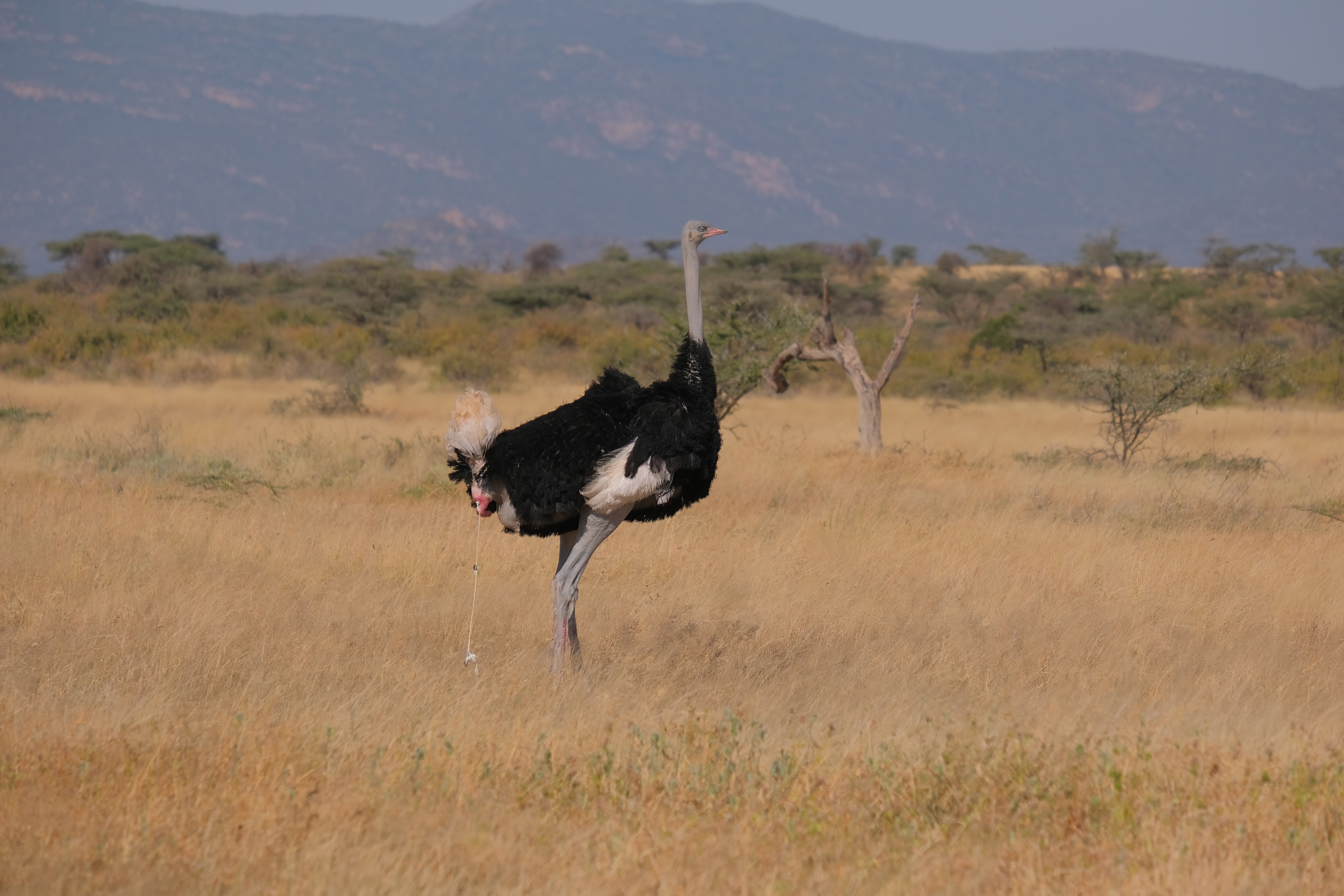 Oops.
Oops.
More weaver bird nests in acacia trees.
Male and female Gerenuk.
We stretched our legs here but had to stay near the vehicle.
The first elephants seen this day.
Superb Starlings.
Marabou Storks.
More elephants (ele's for short!) and lovely Doum palm trees.
Dusting himself.
Guineafowl.
Three Reticulated Giraffe under an acacia tree.
Another elephant.
After lunch at the lodge we enjoy a bit of rest in our room.
Then we head back out for our afternoon game drive and pass a troop of baboons.
A closeup of a baboon by the side of the road.
 Then more baboons including this little baby one hanging around a tree.
Then more baboons including this little baby one hanging around a tree.
Grevy's zebra are named after Jules Grevy and they are the tallest and the most endangered of the 3 species of zebras. Their overall apppearance is slightly closer to that of a mule, compared to the more "equine" horse appearance of the plains or mountain zebras.
Allen and Robinson look for more wildlife.
Never far from the Ewaso Ngiro river
Wart hogs (known as pumbas) characteristically carry their tails upright when they run, waving like a tiny flag!
A nice scene.
 A leopard apparently out on a hunt. A rare find on any game drive, this leopard attracts much attention and appears a bit annoyed by all of the safari vehicles around him.
A leopard apparently out on a hunt. A rare find on any game drive, this leopard attracts much attention and appears a bit annoyed by all of the safari vehicles around him.
We have an opportunity to swim in a natural swimming pool in Buffalo Springs Reserve.
Emerson gets into the clear water. That's Linda A in the background!
Tomorrow we head to Ol Pejeta and Sweetwaters Game Camp.
June 12
Some vervet monkees seem to be saying goodbye as we leave this lovely resort.
Emerson and Linda sat on the bridge over this pretty pool the night before. Linda A, the swimmer in our group, took advantage of swimming at every available pool on this trip including this one!
Linda A and hubby Mike pose for one last photo in front of this pretty Camp Lodge before we board our Land Cruisers to head for Sweetwaters.
It's market day. Here a goat is being shipped on the back of a motorcycle. Motorcycles are used as taxis and transport a variety of cargo!
We see a lot of small stands along the road selling charcoal and other items.
We stop here for bathroom break and some snacks. We learn on this trip that the word "Hotel" means a place to eat.
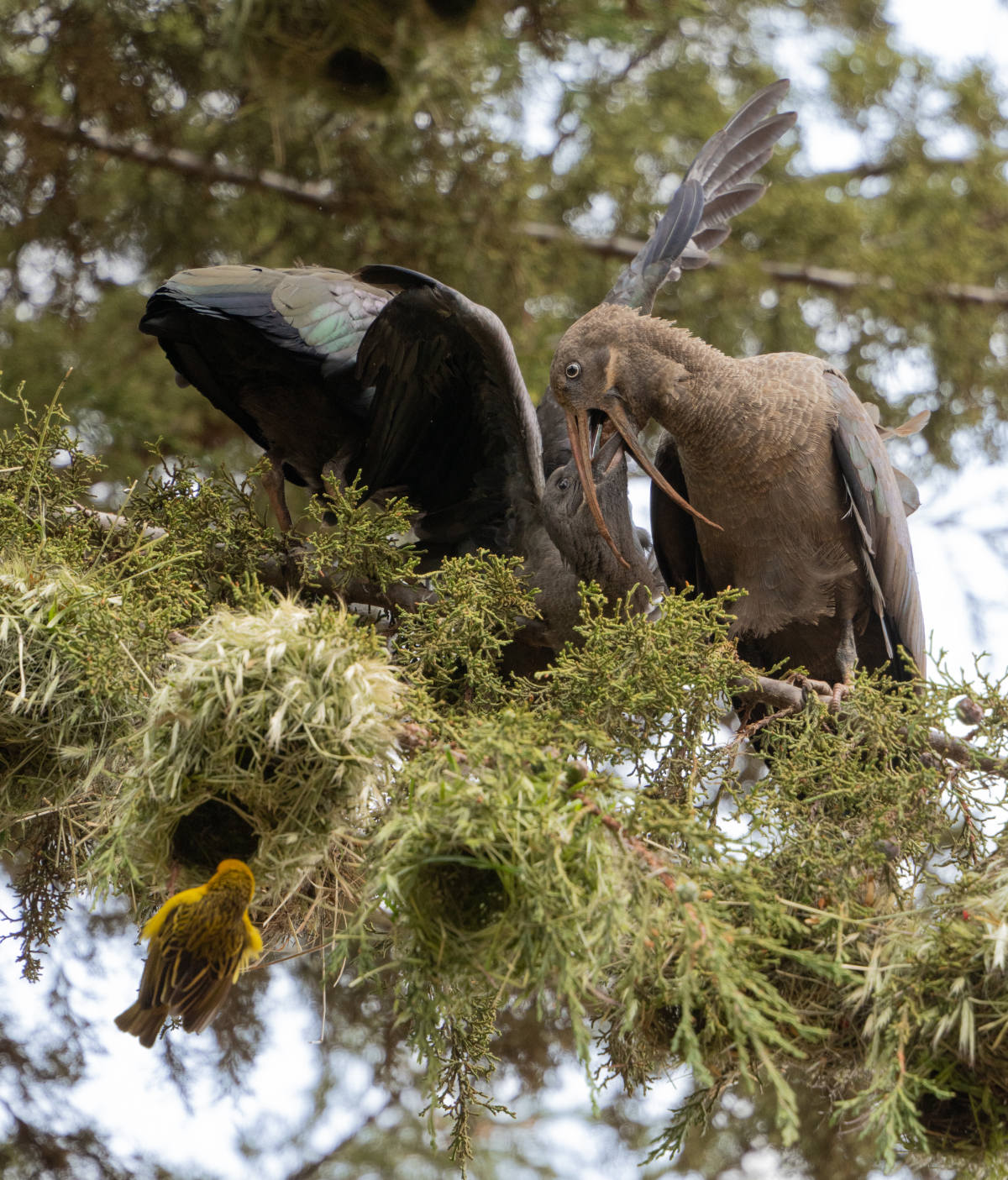 In the back of the Hotel we see birds in action.
Mike Farley photo
In the back of the Hotel we see birds in action.
Mike Farley photo
Allen has provided us our snacks (sweets!) while we purchase our own drinks and then enjoy our break at this nice picnic area out back.
Photo op at this lovely rest stop.
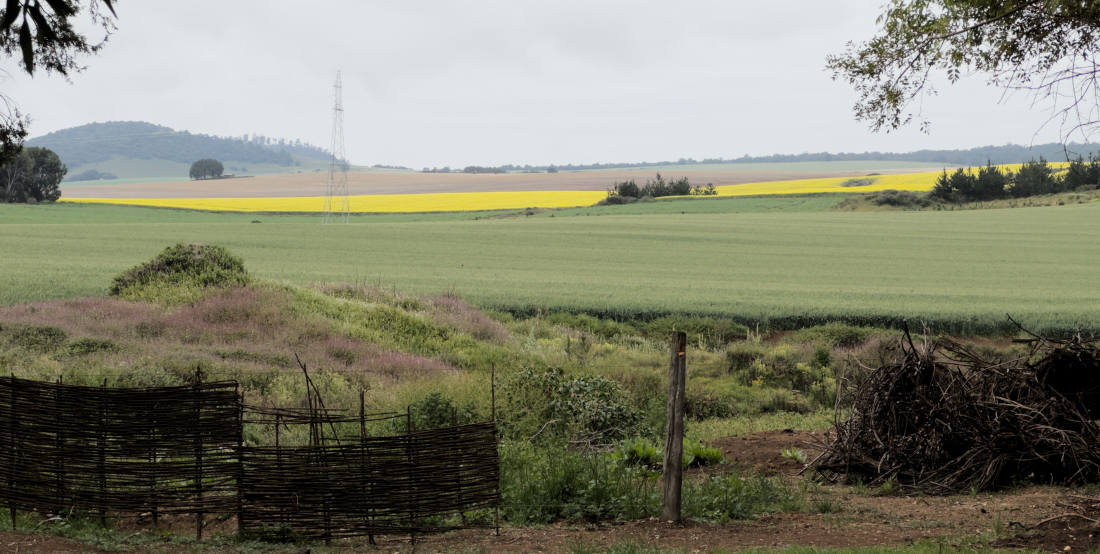 Another view from this picnic area - a large acreage where beautiful yellow flax is growing. A fertile land, we see why these highlands were coveted by the British. There are still some large holdings here. This area has massive greenhouse complexes where roses are raised for export. Elsewhere, locally owned farms are small and and hand labor is used.
Another view from this picnic area - a large acreage where beautiful yellow flax is growing. A fertile land, we see why these highlands were coveted by the British. There are still some large holdings here. This area has massive greenhouse complexes where roses are raised for export. Elsewhere, locally owned farms are small and and hand labor is used.
We stop at a small roadside market.
Allen buys some bananas for us to consume along our way.
We pass through the equator in the town of Nanyuki where a local gives us demonstrations of the coriolis effect.
Photo op right at the equator!
We arrive in time for lunch at Sweetwaters where we will stay the next two nights.
Google view of Sweetwaters reveals it to be an oasis clustered around watering holes set in its own private reserve.
We enjoy lunch in this lovely dining room before we check into our rooms.
The watering hole seen from our open dining room window.
Our tent. Definitely not primative camping.
Our tent #15, sits on a brick platform and has a thatched covered roof.
Our porch view looking toward the watering holes.
Grey crowned cranes near our tented area.
We had a few hours before our afternoon game drive, so Linda A, Debbie and Linda D took a swim in this chilly pool. However, we got used to the temperature quickly on this sunny warm day!
Cape Buffalo in the mud.
Our afternoon game drive
Impala with the distinctive M on the rump (they are sometives referred to as McDonalds impala!).
The animals are looked after. Here is a mobile veterinary vehicle.
An Egyption Goose.
A yellow acacia tree.
A closer view of the end of the elephants trunk.
Full view of ele. Note, she only has one tusk.
At one point when the grass is a bit tough to pull up she uses here foot to help loosen the grass.
Using its foot to help loosen grass.
Emerson, Debbie, Linda A, Mike and Allen all appreciating this special time seeing this beautiful elephant grazing.
A group of zebras is called a dazzle.
A grey crowned crane. (Allen and our group thought gold crowned might be a better name!)
A little mud as sunscreen and insect repellant. A green plant is also stuck on this buffalo.
Back at Sweetwaters Ol Pejeta Conservancy for dinner time.
Enjoying the view of wildlife next to our dining area.
We have a night drive.
Elephants eat for 18 hours a day so they are usually active.
Oh please, not the spot light again.
Mother and baby.
Elands (seen here with some zebras) are the largest antelope, sometimes weighing up to 1 ton! The lights in the background are from the town of Nanyuki.
Allen tells us these are the Common Eland vs the larger Great Eland found in South Africa.
A striped hyena, which Allen is so excited to see! While watching the hyena with binoculars, Linda A sees movement behind it and spots...
..this lion in the distance! We get closer to get this better view.
Video captures his beautiful musculature and confident stride.
Much to admire...so one more video!
We see our first Thompson's gazelles of the trip! Also referred to as tommies, they are small and one of the best known species of gazelles. And they are the 4th fastest land animal, reaching speeds up to 50-55 mph! (cheetah is #1).
A jackal.
Cape Buffalo.
Our next day's schedule.
June 13
Yellow bells is the common name for this pretty tree near out tent at Sweetwaters.
An owl nests on top of Allen's enclosure.
A northern rhino. Mostly solitary animals, they have a pointy triangular mouth better for browsing shrubs and leaves.
Peek-a-boo!
A family group including a nursing baby elephant.
A ranger checks on some Rhino's and they keep an eye on him. In the foreground are Thompson's gazelles and a warthog.
These are white rhinos which we can tell by their wide square shaped mouth (better for grazing grass) and by their social behavior. If you see several rhinos together, it a very good bet they are white rhinos!.
Park Rangers drilling.
In Ol Pejeta Conservancy we meet Baraka, a blind black rhino.
Black rhinos are by nature not at all friendly (labeled as aggressive). Over a long time Baraka became more tame and now allows visitors to feed him.
Baraka's blindness in one eye was due to a fight and in the other due to a cataract. Linda inspects Baraka's horn.
We all get into the photo with Baraka.
Baraka heads out after our visit.
Animals of Ol Pejeta Conservancy.
Linda the gazelle.
A giraffe spine. On the right in this photo, the park ranger is describing a trap and the deadly snares that poachers use.
Differences between white and black rhinos.
Coming full circle from our visit to the National Museum in Nairobi where we saw Sudan, the last male Northern White Rhino, this timeline gives us more backround history about the demise of the Northern Whites. The 2 remaining female Whites reside in Ol Pejeta. Their IVF breeding projects offer some hope for the survival of this subspecies.
Zebras do this cute thing of resting their head and necks on each other's backs.
Cape buffalo .
Easy for us novice travelers to see this lion camoflaged in the grass when near the road. What amazes us is how Allen and our drivers could spot this same scenerio but at great distances.
Grant's gazelle. They can be distinguished from the Thompson Gazelles by the white rump above as well as below their tail.
A few more elephants before heading back to camp for lunch.
Lunch entertainment.
An afternoon break.
Close view of a black rhino at the camp.
Black rhino in motion.
Our afternoon drive. Warthog and piglet with tails upright as they run!
Female reticulated giraffes. The length and dexterity of giraffes' tongues help them avoid thorns when feeding on acacia trees.
This beautiful giraffe moves with such grace.
Later in the afternoon we stop to visit Sweetwaters Chimpanzee Sanctuary, which provides lifelong refuge to orphaned and abused chimpanzees from West and Central Africa. One chimp named Max made a rare appearance to see us at the fence while his fellow chimps remained hidden. We learn Max is an introvert who doesn't like to hang around people and he's also a bit of a troublemaker!
This informative panel tells us how chimps are humans' closest relatives.
Some of the current residents at this Sanctuary are pictured here including Max and Poco.
We learn that Poco was kept in this cage for 9 years before being rescued and sent to this sanctuary.
This is one of several indoor enclosures the chimps return to at night. They have 24 hour veterinary support and have set feeding times. The rest of their days are spent exploring, climbing and socializing within the vast natural sactuary grounds.
Continuing on our afternoon game drive. A Defassa Waterbuck.
Defassa waterbuck's rump is covered by white hair, rather than the dark rump and round white ring of the common waterbuck.
How many lions do you see? There are three.
A cape buffalo with a lot of yellow billed oxpeckers on its back.
Maybe getting a little too personal. The buffalo shook the bird off just after this picture.
The start of a termite mound.
We pass over the equator several times while in Ol Pejeta Conservancy.
We stopped at the equator marker in the park. Allen surprised us by playing "The Lion Sleeps Tonight". We had been singing it in the Land Cruiser spontaniously earlier.
Emerson puts his camera down and joins in the fun!
Enjoying the lodge's fireplace before heading into dinner.
Our last evening meal at Sweetwaters Camp. They are still trying to starve us. Only five desserts and three sauces are visible in this picture.
The altitude in Ol Pajeta (Sweetwaters) is higher (about 6000ft) so the nights are cooler. This hot water bottle tucked under our covers at bedtime is a welcome amenity!
June 14
Every chef in Kenya and Tanzania must have gotten special instructions on how to make a great omelet which we enjoy for our last morning here.
We only get a choice of five juices at breakfast.
One more look at Mt Kenya before we leave Sweetwaters Camp.
Just like in Samburu, Linda takes a photo of the front of the main lodge on the morning we leave! Emerson and Mike here.
On this beginning part of our trip we saw the Samburu Special Five: Reticulated giraffe, Somali ostrich, beisa oryx, gerenuk and the Grevy's zebra.
We are headed back to Nairobi. We stop at a fruit and vegetable market and Charity shows us around.
She was a lot of fun.
More sellers are in the road median.
Motor cycles are used for all types of commerce.
Linda, showing an interest in flora throughout the trip, asks Allen for the name of this native flowering plant as we drive by.
Allen asks our driver to stop. Then Allen hops out and gets a cutting, which Linda's Plantnet app identifies as Mexican Sunflower. Quite a trip leader, that Allen!!
Back in Nairobi, we check back into Hotel Eke, then head out to visit the house of Karen Blixen the author of "Out of Africa" (written under her pen name Isak Dinesen). Nairobi is the Masai name for cold water. The Germans controlled Kenya from the 1880's until WW1 when the British started their occupation.
Karen lived here from 1917 until she returned to Denmark in 1931. (Linda D wishes she could live here now!)
The map of her farm. We were not allowed to take pictures inside the house. A lot of the original home furnishings were found and returned to it after it became a museum.
Rebecca had just started as a guide a few weeks before, but she really knew her material and gave us a good tour.
On the front porch are several framed photos of Karen as well as several of her paintings of the men and women who worked in the house or the farm.
The back of the home and our last group photo of this pre-trip!
The back and side view of this beautiful home which in its day was one of the largest colonial homes in Kenya even hosting the likes of Edward, the Prince of Wales back in 1928.
The coffee drier from 1917 still located on the Estate grounds.
In the evening, we chose to eat at the food court in the shopping mall across from our hotel EKA. We all picked different cuisines which were quite good. Linda A picked Ethiopian which was not Mike's favorite type of food.
It started raining really hard and we had to hang around for awhile until it let up.
Tomorrow we join with the other five travelers and start the rest of our trip.